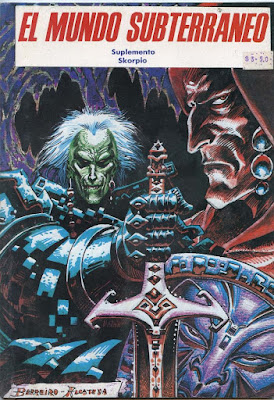Moving Fortress
by Ricardo Barreiro (story) and Enrique Alcatena (art)
adapted by Chuck Dixon and Tim Truman
4Winds Publishing Group, 1988
'Moving Fortress' first was published in 1987 as a serial (La Fortress Movil) in the magazine Skorpio (which circulated in South American and Italy from 1974 to 1996). A sequel, titled El Mundo Subterranea, came later in 1987. 'Bundled' versions of the two comics are available in Spanish editions.
[For an in-depth article, in Spanish, on these comics, readers are directed here.]
In the U.S., veteran comics artist Tim Truman and writer Chuck Dixon formed 4Winds Publishing Group to obtain the rights to issue English translations of comics published in South America and Europe. English translations of 'Moving Fortress' and 'Subterra' (El Mundo Subterranea) were published by 4Winds in 1988 as black-and-white trade paperbacks.
'Moving Fortress' (58 pp) features as its hero the adventurer Bask de Avregaut, who, in the opening pages, is flying in a dirigible over the wasteland. de Avregaut has the misfortune to fly over an extraordinary vehicle: the Moving Fortress, an entire city on wheels.
Shot down by the Fortress's cannoneers, Bask is forced to work as a slave in the engine room, where the eldritch energies used to power the vehicle take their toll on the labor force.
But as luck would have it, a battle with Yathroian airships gives Bask a chance to escape certain death in the engine room. Thanks to his coolness under fire, Bask is instated as a member of the Fortress's crew..........and comes to learn the purpose behind the creation of the Fortress and the single-minded obsession driving its cruel leader, Emir Basileo.............
'Moving Fortress' is one of those comics in which everything comes together so well that it stands as one of the best graphic novels of the 1980s.
Ricardo Barreiro's script has its twists and turns, but never becomes so complicated that it can't be effectively communicated within its 55 pages.
But it's Alcatena's art that really makes 'Moving Fortress' a unique comic. The artwork calls to mind the lithography-based illustration of the 19th and early 20th centuries, particularly the artistry of Aubrey Beardsley and Harry Clarke, along with a pinch of Art Deco. The designs of the uniforms and clothing of the characters, the dirigibles, the cities, the ruined statues in the desert, and the weapons and mounts of the combatants all are imaginative and unlike nothing seen in most standard-issue 'sword and sorcery' comics.
You can get copies of the 4Winds version of 'Moving Fortress' for under $15 from your usual online vendors. Fans of graphic art and fantasy comics definitely will want to have one in their personal library.




























































.jpg)
















